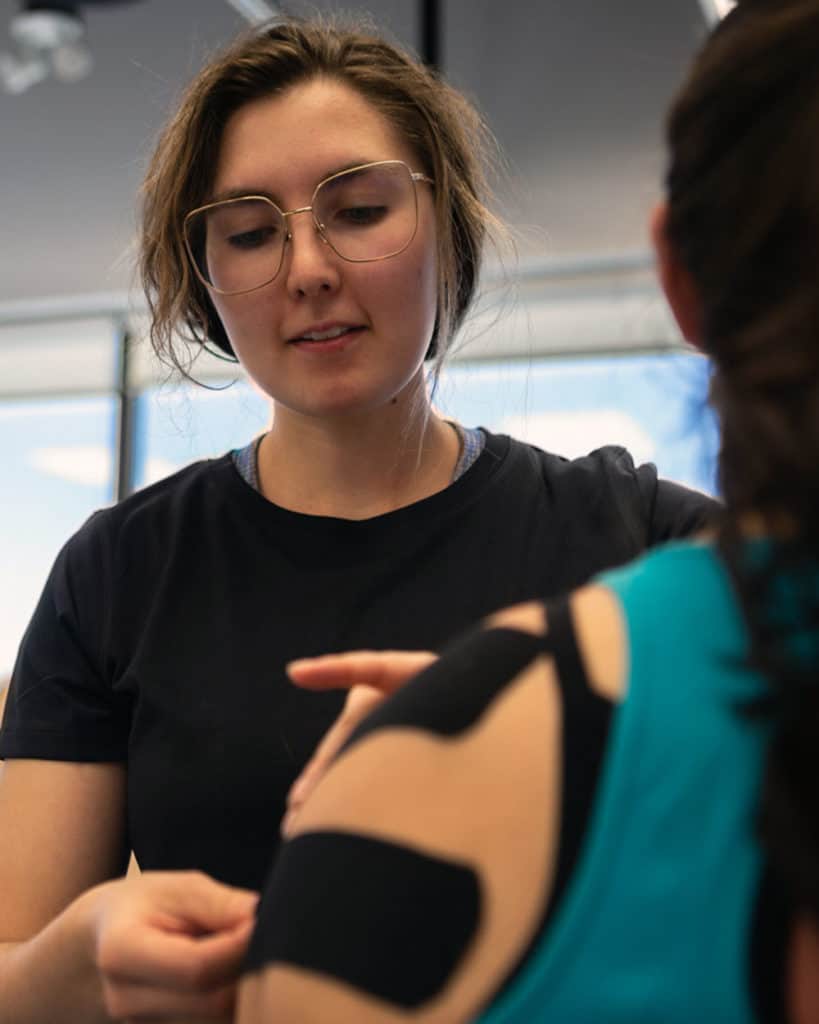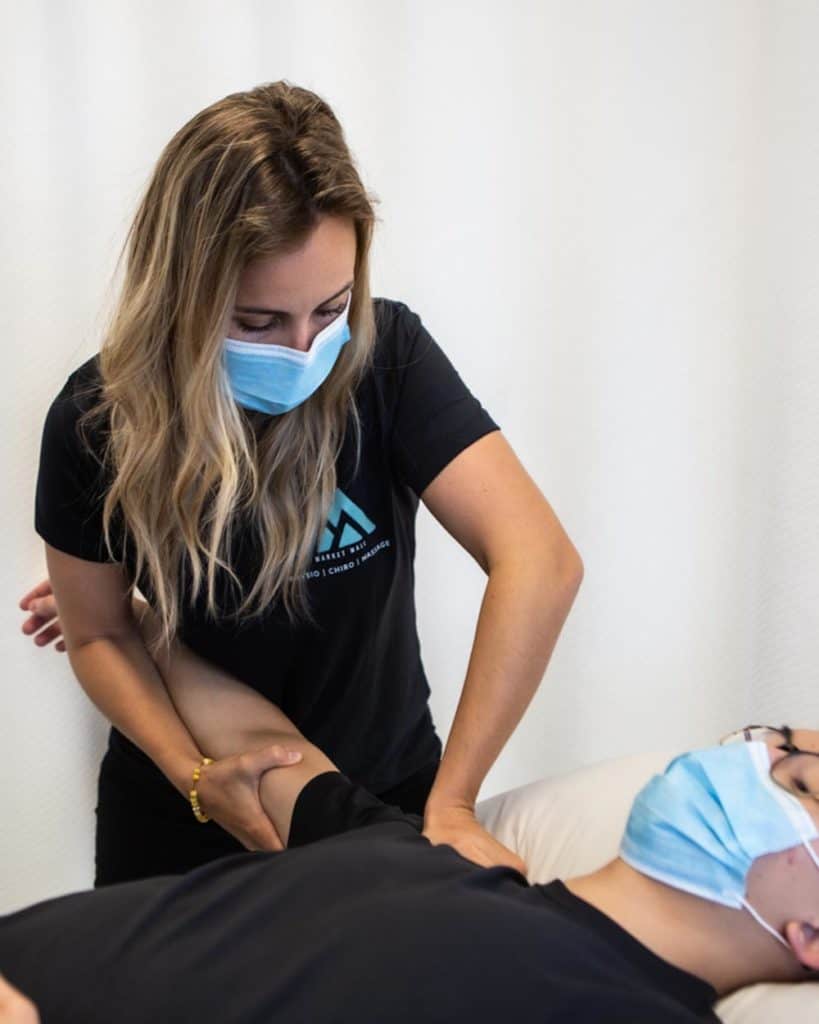
JaneApp Data Security Features: How Your Clinic’s Information Stays Protected
JaneApp Data Security Features: How Your Clinic’s Information Stays Protected Takeaways Jane is HIPAA- and PIPEDA- compliant Data is encrypted, whether at rest or in
Start Feeling Better In As Few As 3 Visits.
If you are one of the many people who suffer from shoulder pain, you know how debilitating it can be. Not being able to use your arm or shoulder can make even the simplest tasks difficult. You may be wondering if physiotherapy can help. In this article, we will discuss how physiotherapy helps relieve shoulder pain and what you can expect from treatment.
Is physiotherapy good for shoulder pain?
Physiotherapy is often recommended as a treatment for shoulder pain. The goal of physiotherapy is to reduce pain and promote healing by helping the individual to regain mobility and range of motion in the affected joint. In addition, physiotherapy can help to strengthen the muscles around the joint, which can help to prevent further stress and injury. There is a wide range of exercises and techniques that can be used in physiotherapy, and a qualified physiotherapist will be able to tailor a treatment plan to the individual’s needs. Generally, physiotherapy is considered to be a safe and effective treatment for shoulder pain.

Tell us what hurts, and we will treat your pain in the shortest time possible. Get effective treatment for your condition in less than 30 minutes so you can get back to doing what you live… pain-free.
Get a personalized care plan so you can feel better in as few as 3 visits. We use advanced therapy techniques proven to ease pain, accelerate recovery, improve mobility and overall health.


Our team of licensed physiotherapists, chiropractors, registered massage therapists are professionals and in human anatomy and biomechanics. You will get the perfect care plan to target the root of your pain so you can get back to doing what you love, everyday!
This appointment is your opportunity to tell us what hurts and discover whether physiotherapy and shoulder pain is a good fit for you! During this session, you will talk with a physiotherapist on a phone call (or online) and create the right care plan specifically for your pain. There is no obligation, this session is only to find out if physiotherapy can help you getting back to doing the things you love in life.
If you’re like most you don’t want to wait days or weeks to get treated for your pain. And you don’t want to have to spend your time calling nearby clinics to find the one who can see you the fastest.
That’s where PainHero comes In – Canada’s largest network of physiotherapists, chiropractors, and registered massage therapists.
Our Platform is used by clinics where they post their open appointment times. So you can quickly compare availability and wait times for clinics near you without having to pick up the phone. Then book an appointment within seconds and even see someone that day if you want. So you can get back to doing the things you love faster.
Plus unlike other sites who let anyone on or just rely on google reviews. We hand pick clinics based on a 50-point inspection, which includes everything from checking reviews, ratings, reputation, history, complaints, satisfaction, trust, cost, and general excellence.
Improve the way your body moves so you can continue to do the things you love. PainHero is Canada’s largest network of physiotherapists, chiropractors, and registered massage therapists. Our mission is to make it easy for you to find the top clinics in your community. We handpick the top clinics using our 50 point inspection based on patient reviews, complaints, and patient outcomes.
Whether you’re seeking pain relief or preventative care, you can expect our patient-centric approach to be new and different from any healthcare experience you’ve had before. Perhaps even life-changing.
1460+
Clinics
2172+
Caring Therapists
2M+
Patient Visits


There are many different types of physiotherapy techniques that can be used to treat many different types of shoulder pain. The best technique for you will depend on the cause and severity of your shoulder pain. For example, if your shoulder pain is due to a traumatic injury, you may benefit from exercises that improves range of motion and flexibility. If your shoulder pain is due to arthritis, you may benefit from exercises that help to strengthen the muscles around the joint. Your physiotherapist will be able to assess your individual needs and recommend the best treatment technique for you.

Physiotherapy uses exercises and other techniques to improve movement and function. It can be used to treat not just shoulder pain but a wide range of conditions. Physiotherapy can help to relieve pain by reducing inflammation and improving range of motion. The exercises used in physiotherapy can also help to strengthen the muscles around the shoulder, which can support the joint and prevent further injury. In addition, physiotherapy can help to improve posture and increase flexibility, both of which can help to reduce the risk of developing shoulder pain. If you are suffering from shoulder pain, physiotherapy may be an effective treatment option for you.
A physiotherapy treatment for shoulder pain can include:
Exercise Therapy:
Exercise is always the number on priority in a physiotherapy treatment program. Exercise therapy is effective in improving range of motion, improving strength and increasing shoulder-related function.
Ice therapy:
One common treatment for shoulder pain is ice therapy. Ice therapy can help to reduce inflammation and pain by numbing the affected area. It is typically used for acute injuries or flare-ups of chronic conditions. Ice therapy is usually applied for 15-20 minutes at a time, multiple times per day.
Heat therapy:
Heat therapy is another common treatment for shoulder pain. Heat therapy can help to reduce pain by increasing blood flow to the affected area and by increasing flexibility of the tissues surrounding the shoulder. It is typically used for chronic conditions or injuries that have not responded well to other treatments. Heat therapy is usually applied for 15-20 minutes at a time, multiple times per day. Some people may find relief from using heat packs, heating pads, or taking warm baths.
Hands-on physiotherapy
There is a growing body of evidence that supports the efficacy of hands-on physiotherapy techniques such as massage, manipulation, and mobilisation. These techniques can help to reduce pain, improve range of motion, and speed up the healing process. A number of studies have shown that hands-on physiotherapy can be particularly effective for treating musculoskeletal conditions such as back pain, neck pain, and shoulder pain. In addition, hands-on physiotherapy can also be used to treat a variety of other conditions such as headaches, migraines, and tension headaches. While there are a number of different hands-on physiotherapy techniques, all share the common goal of helping patients to feel better and move more freely.
Electrical Stimulation
Electrical stimulation is a common physiotherapy treatment for shoulder pain that is used to help reduce pain and promote healing. The therapy involves the use of electrical currents to stimulate the muscles and nerves. This can help to reduce inflammation, increase blood flow, and improve range of motion. Electrical stimulation is often used in conjunction with other physiotherapy treatments, such as massage and exercises. The goal of the therapy is to help the patient regain function and improve their quality of life. Electrical stimulation is a safe and effective treatment that has been shown to be beneficial for a variety of conditions.
Heat vs. ice (when to apply) courtesy of INNOVA Integrated Wellness Centre. (Read the caption)
Find out whether physiotherapy and shoulder pain can help you get back to doing the things you love in life.
The most common cause of shoulder pain is a rotator cuff injury. The rotator cuff is a group of 4 muscles and tendons that attach the shoulder blade to the upper arm bone. These muscles and tendons work together to lift the arm and keep the shoulder joint in place. However, they can become weak or damaged due to overuse, injury, or age. As a result, the shoulder joint can become unstable, leading to pain and inflammation. Treatment for a rotator cuff injury typically includes rest, ice, and physiotherapy. In some cases, surgery may also be necessary.
A rotator cuff injury is a common type of shoulder injury that can cause pain and limited range of motion. However, physiotherapy can be an effective treatment for this condition. Through a combination of exercises and stretches, physiotherapy can help to improve range of motion and flexibility, as well as reduce pain. In addition, physiotherapy can help to prevent further damage to the rotator cuff by strengthening the rotator cuff muscles. As a result, physiotherapy can be an important part of recovery for those who have suffered a rotator cuff injury.
Check out this video to learn the great way to assess the mobility of your shoulders courtesy of PhysioPlus Health Group (Read the caption)
Doorway Stretch – This stretch is performed by standing in a doorway with your arm at a 90-degree angle. With your arm against the doorway, slowly lean forward until you feel a stretch in the front of your shoulder. Hold this position for 30 seconds and repeat three times.
Pendulum Exercise – This exercise is performed by holding onto a sturdy object such as a table or chair. Lean over the object and allow your body to swing your arms in a circular motion. Start with small circles and gradually increase the size of the circle. Repeat this exercise for 30 seconds and perform three sets.
Banded Row- This exercise is performed by sitting up tall in a chair with upright posture. Place a band around a doorknob in your home and hold both ends Squeeze your shoulder blades together and pull you arms back against the resistance of the band. Repeat this exercise for 10 repetitions and perform three sets.
These are just a few of the many exercises that can be performed to help reduce shoulder pain. If you are experiencing shoulder pain, it is important to consult with a physiotherapist to determine which exercises are best for you.
Reasons to see a hand therapist courtesy of Active Recovery Physiotherapy and Hand Clinic (Read the caption)
You should consult a doctor if the pain is severe, does not improve with home treatment, or is accompanied by other symptoms, such as numbness or weakness.
It can feel like a toothache-type sensation. Additionally, you may experience popping, catching, and clicking sensations in your shoulder.
The best sleep position for shoulder impingement is sleeping on your back. If you are a side sleeper, however, you may prefer to sleep on the non-painful side. Placing a pillow between the injured arm and your trunk can also be helpful.
Yes! Most people with shoulder impingement respond very favorably with physiotherapy.
Most of the time it’s normal and not harmful. If it the cracking is associated with pain then you should see a doctor or Physiotherapist to see what’s going on.
The length of time required for physiotherapy will vary depending on the severity of the shoulder pain as well as the individual factors of the person being treated. In most cases, a course of physiotherapy will last for several weeks. However, some people may need to continue physiotherapy for longer in order to achieve their desired results. Your physiotherapist will be able to give you an indication of how long your physiotherapy will take.

Physiotherapy is generally considered to be a safe and effective treatment option for a variety of conditions. However, as with any treatment, there are potential risks and side effects associated with physiotherapy. The most common side effect of physiotherapy is soreness or tenderness at the site of treatment. This is typically mild and will resolve on its own within a few days. Other potential side effects of physiotherapy include bruising, swelling, and redness. These side effects are usually mild and will resolve within a few days.
Physiotherapy courtesy of Equilibrium (Read the caption)
If you are considering physiotherapy for your shoulder pain, you may be wondering what to expect. During your first visit, your physiotherapist will take a detailed history and conduct a physical examination. They will then develop a treatment plan specifically for you. Treatment may include manual therapy, exercises, and modalities such as heat or cold therapy.
Your physiotherapist will teach you how to perform the exercises correctly and will progress them as your pain improves. Treatment typically lasts for several weeks, although the exact length of time will depend on the severity of your shoulder pain. With regular attendance, most people experience a significant reduction in their shoulder pain. If you are considering physiotherapy for your shoulder pain use the search box on this page to find a top physiotherapy clinic near you.
Benefits of Physical Activity courtesy of Athlete’s Care (Read the caption)
Red flags for shoulder pain include a history of trauma or a fall, night pain, tingling or numbness in the shoulder or arm, pain that has been increasing over time, a history of cancer, or a fever. If any of these symptoms are present, it is important to seek medical attention.

JaneApp Data Security Features: How Your Clinic’s Information Stays Protected Takeaways Jane is HIPAA- and PIPEDA- compliant Data is encrypted, whether at rest or in

JaneApp Reporting and Analytics: How Clinics Can Track Growth and Performance Takeaways Jane’s reports are super underrated, they give you real insight into how your

JaneApp Customer Support: How to Get the Help Your Clinic Needs Takeaways Use the in-app chat first if you can Email is fine, but be
The frequency of physical therapy will depend on the severity of your condition. For most people, once a week is enough to see significant improvements. However, some people may need to come more often at the beginning of treatment and then taper off as their condition improves.
Again, this will depend on the severity of your condition. Most sessions last between 30-60 minutes.
You should wear comfortable clothing that you can move around in. It is also important to wear shoes that provide good support. If you have any questions about what to wear, be sure to ask your physiotherapist.

Taylor is a physiotherapist at The Orthopaedic Therapy Clinic located in Toronto, Ontario. He treats patients with various musculoskeletal conditions using patient education, exercise therapy, manual therapy and acupuncture. His treatment philosophy involves giving his patient’s the means to self-manage their injuries. He does this through reassurance, education and health promotion. Taylor uses the same principles as a patient educator at Pain Hero. He aims to provide you with high-quality, easy to understand information to teach you about your condition and how to improve it.
Physiotherapy and Shoulder Pain is one of several possible methods for relieving pain that do not rely on prescription medications and all the side effects and baggage they come with. Not to mention that most drugs can only mask pain, but rarely address root causes. Find a clinic if you are suffering from muscle tightness, soreness, or pain to improve your quality of life, today.
